 |

Lecture-14
Process of
Dimensional Modeling
The
Process of Dimensional
Modeling
Four Step
Method from ER to DM
1.
Choose
the Business Process
2.
Choose
the Grain
3.
Choose
the Facts
4.
Choose
the Dimensions
A typical ER diagram covers
the entire spectrum of the
business, actually covers every
possible
business
process. However, in reality those
multitudes of process do not co
-exist in time and
space
(tables). As a consequence, an ER diagram is
overly complex, and is a demerit to
itself.
This is
precisely the point that
differentiates a DM from an ER diagram, as a single ER
diagram
can be
divided into multiple DM
diagrams. Thus a step-wise approach is
followed to separate
the
DMs
from an ER diagram, and this
consists of four
steps.
Step
-1: Separate the ER diagram
into its discrete business
processes and to model each
business
process
separately.
Step
-2: Grain of a fact table =
the meaning of one fact
table row. Determines the
maximum level
of detail of
the warehouse.
Step
-3: Select those many-to-many
relationships in the ER model containing
numeric and
additive non-key
items and designate them as
fact tables. Actually all business
events to be
analyzed
are gathered into fact
tables.
Step
-4: De-normalize all of the remaining
tables into flat tables
with single -part keys that
connect
directly to
the fact tables. These
tables become the dimension
tables. They are like
reference
tables
that define how to analyze
the fact information. They
are typically small and
relatively
static.
Let's
discuss each of the steps in
detail, one by one.
S tep-1:
Choose the Business
Process
�
A business
process is a major operational process in
an organization.
�
Typically
supported by a legacy system
(database) or an OLTP.
� Examples:
Orders, Invoices, Inventory
etc.
�
Business
Processes are often termed
as Data Marts and that is
why many people
criticize
DM as being data
mart oriented.
The
first step in DM is the
business process selection.
What do we mean by a process? A
process
is a natural
business activity in the organization
supported by a legacy source
data-collection
99
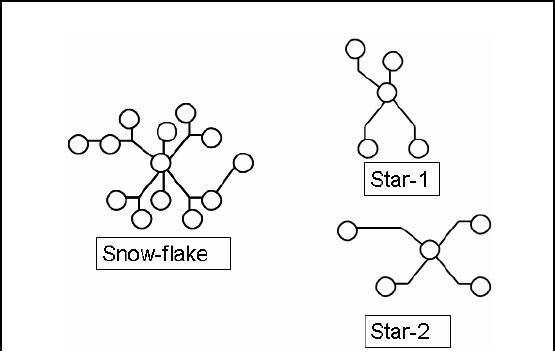
system
(database or OLTP). Example
business processes include purchasing,
orders, shipments,
invoicing,
inventory, and general ledger
etc.
Many
people consider business
processes as Data marts i.e.
in their view organizational or
depart
mental function is referred as
the business process. That
is why such people criticize DM
as
being a data
mart oriented approach. However, in
Kimball's view, it is a wrong
approach, the
two
must not be confused e.g. a single
model is built to handle orders
data rather than
building
separate
models for marketing and
sales departments, which
both access the orders
data. By
focusing on
business processes, rather
than departments, consistent
information can be
delivered
economically throughout
the organization . Building departmental
data models may result in
data
duplication,
data inconsistencies, and
data management issues. What
is a possible solution?
Yes,
publishing data
once can not only
reduce the consistency
problems, but can also
reduce ETL
development ,
data management and disk
storage issues as
well.
Step-1:
Separating the
Process
Figure-14.1:
Step-1: Separating the
Process
Fig-14.1
shows an interesting concept
i.e. separating business
processes to be modeled from
a
complex
set of processes. This
translates to splitting a snow-flake
schema into multiple
star
schemas. Note
that as the processes move
into the star schema
all the hierarchies
collapse.
100

Step-2:
Choosing the Grain
�
Grain is
the fundamental, atomic level
ofdata to be represented.
�
Grain is
also termed as the unit of
analyses.
�
Example
grain statements
�
Typical
grains
� Individual
Transactions
� Daily
aggregates (snapshots)
� Monthly
aggregates
�
Relationship
between grain and
expressiveness.
�
Grain vs.
hardware trade-off.
Grain is
the lowest level of detail or the
atomic level of data stored
in the warehouse. The
lowest
level of
data in the warehouse may
not be the lowest level of data
recorded in the
business
system. It is
also termed as the unit of
analysis e.g. unit of weight
is Kg etc.
Example
grain statements: ( one
fact row represents a...)
� Entry
from a cash register
receipt
� Boarding
pass to get on a
flight
� Daily
snapshot of inventory level
for a product in a
warehouse
� Sensor
reading per minute for a
sensor
� Student
enrolled in a course
Finer-grained fact
tables:
� are
more expressive
� have
more rows
Trade
-off between performance and
expressiveness
� Rule of
thumb: Err in favor of
expressiveness
� Pre-computed
aggregates can solve performance
problems
In the
absence of aggregates, there is a
potential to waste millions of dollars on
hardware
upgrades to
solve performance problems that could
have been otherwise addressed
by
aggregates.
101
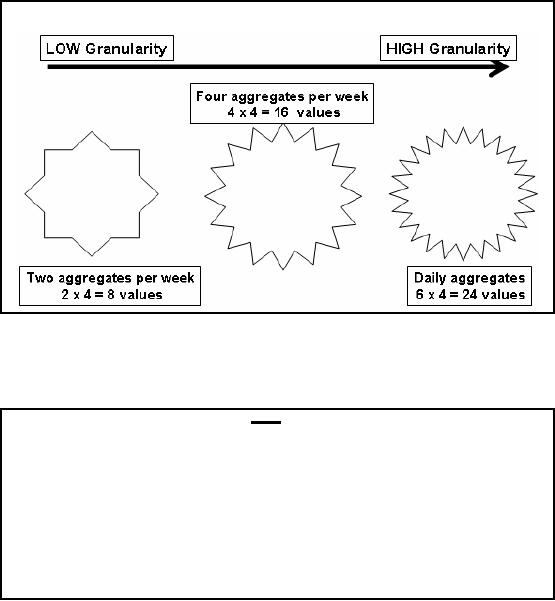
Step-2:
Choosing the Grain
Figure-14.2:
Step-2: Choosing the
Grain
Note
that you may come across
definitions of grain as given in
the notes and discussed in
the
lectures, but
you may also come across
definitions that are
different from those
discussed. This
depends on
the interpretation of the writer. We
will follow the definition
as per Fig-14.2.
The
case FOR data
aggregation
�
Works
well for repetitive
queries.
�
Follows
the known thought
process.
�
Justifiable if
used for max number of
queries.
�
Provides a "big
picture" or macroscopic
view.
�
Application
dependent, usually inflexible to
business changes (remember
lack of
absoluteness of
conventions).
There
are both positives and negatives to data
aggregation. These are a list of
the reasons for
the
utilization of
summary or aggregate data . As you
can see, they all
really fall under the area
of
"performance".
The negative
side is that summary data
does not allow a total solution with
the flexibility and
capabilities
that some businesses truly
require as compared to other
businesses.
102
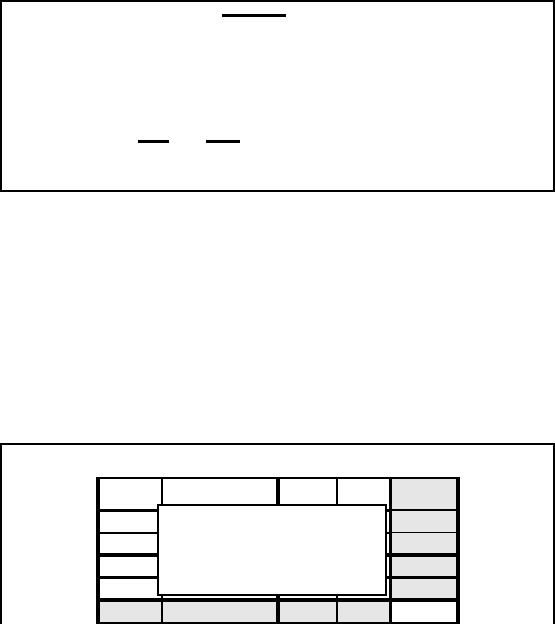
The
case AGAINST data
aggregation
�
Aggregation is
irreversible.
� Can
create monthly sales data
from weekly sales data, but
the reverse is not
possible.
�
Aggregation
limits the questions that
can be answered.
� What,
when, why, where , what-else,
what-next
�
Aggregation
can hide crucial facts.
� The
average of 100 & 100 is
same as 150 & 50
Aggregation is one-way
i.e. you can create
aggregates, but can not dissolve
aggregates to get the
original
data from which the
aggregates were created. For
example 3+2+1 = 6 at the
same time
2+4
also equals 6, so does 5+1
and if we consider reals,
then infinetly many ways of
adding
numbers to
get the same
result.
If you
think about the "5 W's of
journalism", these are the
"6 W's of data analysis".
Again it
highlights the
types of questions that end
users want to ask and
can not be answered by
summary
data.
By definition, a
summarization will consider at
least one of these points
irrelevant. For
example,
a summary
across the company takes out
the dimension of "WHERE" and
a summary by quarters
takes out
the element of "WHEN". The
point to be noted is that although
summary data has a
purpose,
yet one can take
any summary and ask a
question that the system
can not answer.
Aggregation
hides crucial
facts
Week -1
Week-2 Week -3 Week-4
Average
Zone-1
100
100
100
100
100
Just
Looking at the averages
i.e.
Zone-2
50
100
150
100
100
aggregates
Zone-3
50
100
100
150
100
Zone-4
200
100
50
50
100
Average
100
100
100
100
Table-14.1:
Aggregation hides crucial
facts
Consider the
sales data of an item sold in a
chain store in four zones,
such that the sales
data is
aggregated
across the weeks also.
For this simple example,
for the sake of conserving
space the
average sales
across each zone and
for each week is stored.
Therefore, instead of storing 16
values only 8
values are stored i.e. a
saving of 50% space.
Assume
that a promotional scheme or
advertisement campaign was run,
and then the sales
data
was
recorded to analyze the
effectiveness of the campaign. If we
look at the averages (as
shown
in the
table) there is no change in
sales i.e. neither across time
nor across the
geography
103
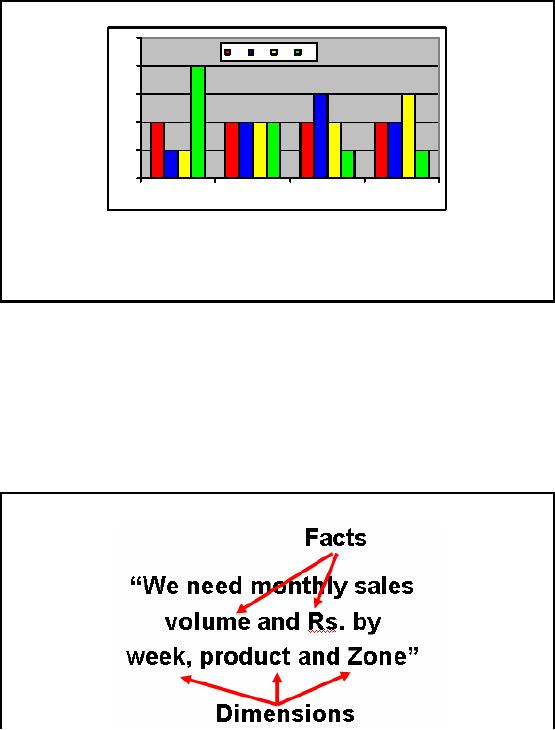
dimension. On
the face of it, it was an in
effective campaign. Now lets
raise the curtain and
look
at the
detailed sales records. The
numbers are NOT constant!
Drawing the graphs of the
sales
records,
shows a very different
picture.
Aggregation
hides crucial
facts
250
Z1
Z2
Z3
Z4
200
150
100
50
0
Week-1
Week-2
Week-3
Week-4
Z1:
Sale is
constant
(need to work on it)
Z2:
Sale went up, then
fell (need of
concern)
Z3:
Sale is on the rise,
why?
Z4:
Sale dropped sharply, need
to look deeply.
W2:
Static sale
Figure-14.3:
Aggregation hides crucial
facts
Z1:
Sale is constant through out the month
(need to work on it)
Z2:
Sale went up, then fell
(need of concern) i.e. the
campaign was effective, but
after week it
fizzled
down.
Z3:
Sale is on the rise,
why?
Z4:
Sale dropped sharply, need to
look deeply. It seems that
the campaign had a negative
effect
on the
sales?
W2: Static
sale across all zones,
very unique indeed.
Step 3:
Choose Facts
104
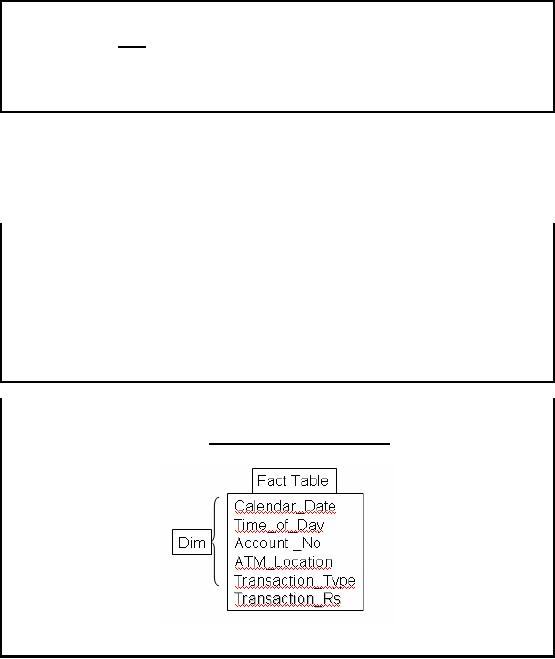
Numeric
facts are identified by answering the
question "what are we
measuring?" Many- to-
many
relationships in the ER model containing numeric
and additive non -key items
are selected
and
designated as fact tables. In
the example numeric additive figures
volume
(quantity
ord ered)
and
Rs. (Rupees
cost amount) are the facts
because the numeric values of the
two are of keen
interest
for the business
user.
Step 3:
Choose Facts
�
Choose
the facts that will
populate each fact table
record.
�
Remember
that best Facts are Numeric,
Continuously Valued and Additive.
�
Example:
Quantity Sold, Amount etc.
It should be
remembered that facts are
numeric, continuous, additive
and non -key items that
will
populate
the fact table. Example
facts for a point of sales
terminal (POS) are sale s quantity,
per
unit
sales price, and the
sales amount in rupees. All
the candidate facts in a
design must be true to
the
grain described in previous
slides. Facts that clearly belong to a
different grain must be in
a
separate fact
table.
Step 4:
Choose Dimensions
�
Choose
the dimensions that apply to
each fact in the fact
table.
�
Typical
dimensions: time, product,
geography etc.
�
Identify
the descriptive attributes that explain
each dimension.
�
Determine
hierarchies within each
dimension.
Step-4:
How to Identify a Dimension?
�
The
single valued attributes
during recording of a transaction are
dimensions.
Time_of_day:
Morning,
Mid Morning, Lunch Break
etc.
Transaction_Type: Withdrawal,
Deposit, Check balance
etc.
Table-14.2:
Step-4: How to Identify a
Dimension?
105
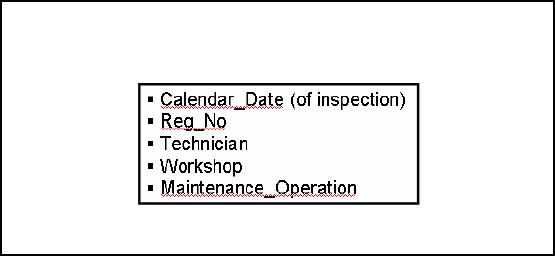
The dimension
tables, usually represent textual
attributes that are already
known about things
such as
the product, the geography,
or the time. If the database
designer is very clear about
the
grain of
the fact table, then
choosing the appropriate dimensions
for the fact table is
usually easy.
What is so
special about it, seems to be
pretty intuitive, but is
not.
The
success in selecting the
right dimensions for a given
fact table is dependent on
correctly
identifying
any d scription that has a
single value for an
individual fact table record
or
e
transaction.
Note that the fact table record
considered could be a single transaction
or weekly
aggregate or
monthly sums etc i.e. a
grain is associated. Once
this is correctly ident ified
and
settled,
then as many dimensions can
be added to the fact able as
required. For the ATM
customer
transaction
example, the following
dimensions all have a single
value during the recording of
the
transaction, as
none of the above dimensions
change during a single
transaction:
�
Calendar_Date
�
Time_of_Day
�
Account
_No
�
ATM_Location
�
Transaction_Type
(withdrawal, deposit, balance
inquiry etc.)
Over
here Time_of_Day refers to specific
periods such as Morning, Mid
Morning, Lunch Break,
Office_Off
etc. Note that during an
atomic transaction, the
value of Time_of_Day does
not
change
(as a transaction takes less
than a minute), hence it is a dimension.
In the context of the
ATM
example, the only numeric attribute is
the Transaction_Rs, so it is a fact.
Observe that we
use
this convention in real life
also, when people say we
will visit you first time or
second time of
the
day etc.
Step-4:
Can Dimensions be
Multi-valued?
�
Are
dimensions ALWYS
single?
� Not
really
� What
are the problems? And
how to handle them
�
How
many maintenance operations
are possible?
� Few
� Maybe
more for old
cars
Figure-14.4:
Step-4: Can Dimensions be
Multi-valued?
After
convincing ourselves that
dimensions are really single
valued, perhaps we should
consider
whether there
are ever legitimate exceptions
i.e. is it possible to have
multi-valued dimension in a
fact table? If
this is conceivable, what problems
might arise?
Consider
the following example from
vehicle maintenance system
used at a vehicle service
center.
You are handed a data
sheet for which the
grain is the individual line
item on the
customer's
bill. The data source could
be your periodic car
maintenance visits to the
company
106

workshop or
individual replacement charges on a
repair/change bill. These
individual line items
have a
rich set of dimensions such
as:
�
Calendar_Date
(of inspection)
�
Reg_No
(of vehicle)
�
Technician_ID
�
Workshop
�
Maintenance_Operation
The numeric
additive facts in this
design (which are the
core of every fact table in a
dimensional
design)
would include Amount_Charged and perhaps
others including Amount_Paid,
depending
upon if
the vehicle was insured
etc.
On the
face of it, this seems to be a
very straightforward design,
with obvious single values
for all
the
dimensions. But there is a surprise. In
many situations, there may
be multiple values for
services
performed, such as oil change,
air filter change, spark
plug change etc. What do you
do if
for a certain
car there are three
separate changes at the
moment the service was performed?
How
about really
old and ill-kept cars
that might have upto 5+ such
changes? How do you encode
the
Maintenance_Operation
dimension if you wish to represent this
information?
Step-4:
Dimensions & Grain
�
Several grains
are possible as per business
requirement.
�
For
some aggregations certain
descriptions do not remain atomic.
�
Example:
Time_of_Day may change several
times during daily
aggregate, but
not
during a transaction
�
Choose
the dimensions that are
applicable within the selected
grain.
Strangely,
there is a relationship between the
grain and the dimensions.
When building a fact
table,
the most important step is to
declare the grain (aggregation
level) of the fact table.
The
grain
declares the exact meaning
of an individual fact record. Consider
the case of
transactions
for an
ATM machine. The grain could
be individual customer transaction, or
number of
transaction per
week or the amount drawn per
month.
�
Calendar_Date
�
Time_of_Day
�
Account
_No
�
ATM_Location
�
Transaction_Type
(withdrawal, deposit, balance
inquiry etc.)
Note that
none of the above dimensions
change during a single
transaction. However, for
weekly
transactions
probably only Account _No
and ATM_Location can be
treated as a dimension.
Note
that higher the level of
aggregation of the fact table,
the fewer will be the
number of
dimensions you
can attach to the fact
records. The converse of
this is surprising. The
more
granular the
data, the more dimensions
make sense. Hence the
lowest-level data in
any
organization is
the most dimensional.
107
Table of Contents:
- Need of Data Warehousing
- Why a DWH, Warehousing
- The Basic Concept of Data Warehousing
- Classical SDLC and DWH SDLC, CLDS, Online Transaction Processing
- Types of Data Warehouses: Financial, Telecommunication, Insurance, Human Resource
- Normalization: Anomalies, 1NF, 2NF, INSERT, UPDATE, DELETE
- De-Normalization: Balance between Normalization and De-Normalization
- DeNormalization Techniques: Splitting Tables, Horizontal splitting, Vertical Splitting, Pre-Joining Tables, Adding Redundant Columns, Derived Attributes
- Issues of De-Normalization: Storage, Performance, Maintenance, Ease-of-use
- Online Analytical Processing OLAP: DWH and OLAP, OLTP
- OLAP Implementations: MOLAP, ROLAP, HOLAP, DOLAP
- ROLAP: Relational Database, ROLAP cube, Issues
- Dimensional Modeling DM: ER modeling, The Paradox, ER vs. DM,
- Process of Dimensional Modeling: Four Step: Choose Business Process, Grain, Facts, Dimensions
- Issues of Dimensional Modeling: Additive vs Non-Additive facts, Classification of Aggregation Functions
- Extract Transform Load ETL: ETL Cycle, Processing, Data Extraction, Data Transformation
- Issues of ETL: Diversity in source systems and platforms
- Issues of ETL: legacy data, Web scrapping, data quality, ETL vs ELT
- ETL Detail: Data Cleansing: data scrubbing, Dirty Data, Lexical Errors, Irregularities, Integrity Constraint Violation, Duplication
- Data Duplication Elimination and BSN Method: Record linkage, Merge, purge, Entity reconciliation, List washing and data cleansing
- Introduction to Data Quality Management: Intrinsic, Realistic, Orr’s Laws of Data Quality, TQM
- DQM: Quantifying Data Quality: Free-of-error, Completeness, Consistency, Ratios
- Total DQM: TDQM in a DWH, Data Quality Management Process
- Need for Speed: Parallelism: Scalability, Terminology, Parallelization OLTP Vs DSS
- Need for Speed: Hardware Techniques: Data Parallelism Concept
- Conventional Indexing Techniques: Concept, Goals, Dense Index, Sparse Index
- Special Indexing Techniques: Inverted, Bit map, Cluster, Join indexes
- Join Techniques: Nested loop, Sort Merge, Hash based join
- Data mining (DM): Knowledge Discovery in Databases KDD
- Data Mining: CLASSIFICATION, ESTIMATION, PREDICTION, CLUSTERING,
- Data Structures, types of Data Mining, Min-Max Distance, One-way, K-Means Clustering
- DWH Lifecycle: Data-Driven, Goal-Driven, User-Driven Methodologies
- DWH Implementation: Goal Driven Approach
- DWH Implementation: Goal Driven Approach
- DWH Life Cycle: Pitfalls, Mistakes, Tips
- Course Project
- Contents of Project Reports
- Case Study: Agri-Data Warehouse
- Web Warehousing: Drawbacks of traditional web sear ches, web search, Web traffic record: Log files
- Web Warehousing: Issues, Time-contiguous Log Entries, Transient Cookies, SSL, session ID Ping-pong, Persistent Cookies
- Data Transfer Service (DTS)
- Lab Data Set: Multi -Campus University
- Extracting Data Using Wizard
- Data Profiling